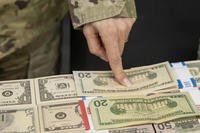My primary financial goal for 2012 is to cut down on the amount of money my family spends on food. Well, it is quickly nearing the end of April and I feel like I've made little progress. What is most frustrating is that I know how to do it, but I'm not actually doing it. So I'm writing this post for me, and maybe some of you will join me.
The five things that I know I need to do to cut my food costs are making menus, using what we have, reduce waste, decreasing money spent on foods away from home, and choosing frugal options.
Make Menus
If you've been reading The Paycheck Chronicles, you are probably thinking to yourself: "For goodness sakes, Kate, you talk about making menus all the time. Are you saying that you don't do it?" And the answer is: sometimes. I'll be super-duper good about making menus, then I'll slack off. Sometimes my slacking periods last weeks, months,...I don't think years. And when I don't make menus, there are far too many cereal mornings and canned soup nights. Not scheduled cereal mornings or canned soup nights, but times when the kids ask what is for dinner and, in a fit of desperation, I suggest cereal or soup.
Which brings me back to making menus. It doesn't matter how you make your menus, as long as you do it. I use a chart printed on a piece of paper. Other creative ideas:
- Putting small post-it notes on your calendar. This is a great idea because you can move the notes if your schedule changes. Just don't push a post-it so far down your calendar that the ingredients go bad.
- Use a menu making app for your smart phone. Two that I know are Menu Planner and The Cooking Light Quick and Healthy Menu Maker. I'm sure there are more out there. One serious disadvantage to using an online program or app is that it isn't as sharable as something posted in the kitchen. It isn't going to be as effective at cutting the constant questions, or as likely that someone else will look at the menu and start dinner.
Be sure that your menu notes any special events or scheduling conflicts. Evening activities are the source of many food frustrations. Knowing when and where you have what can make the difference between just writing a menu and actually using a menu.
Some people like to map out breakfast, lunch, dinner and snacks. That is awesome! If you find this overwhelming, you might start with just dinner and work your way up.
Another idea is to have some sort of set menu plan from which you build. For example, it might be Monday pasta, Tuesday tacos, Wednesday chicken, Thursday pork and Friday fish. For several years, my family had a regular breakfast rotation and it sure did make mornings less stressful. I should probably try that again, huh?
Use What You Have
For me, this is part of making menus. The first step in making menus is to do a rough inventory of what's in the freezer and fridge, plus any interesting things in the pantry. My list might say: pork chops, sweet italian sausage, leftover chicken, rice, dried beans. I start brainstorming ideas to use those items before I move on to the rest of my list.
Another thing to consider in your menu planning is reusing ingredients from earlier meals. Hamburgers = chili = chilimac. Tacos = taco salad. Roast chicken = chicken soup or chicken casserole or chicken and dumplings. Buying celery to put in soup? Put tuna salad on the menu for lunch the next day. You get the picture.
Don't forget to factor leftovers into your plan, as well. My family deals with leftovers in a variety of ways. At least one serving of any leftover meal goes into a glass freezer container for my husband to take to work. I often eat leftovers during my day. And we have a leftovers night whenever necessary. It used to be called Smorgasbord night, because my kids liked the word when they were little, now we call it CORN - Clean Out the Refrigerator Night.
Some people have elaborate systems for keeping track of the foods in their fridge or freezer. If that works for you, great. As I get older, I am losing ability to remember exactly what we do and do not have on hand. A good inventory system can help, or you can just go through the fridge and freezer every couple of days, like I do.
Reduce Waste
Oh, gosh, this is the hardest part for my family. Or maybe the second hardest, but it is close. There are so many ways that my family wastes food. From something as simple as pouring too much milk or juice and then not drinking it, to defrosting meat and then failing to cook it in a timely manner, I am appalled at the amount of food we throw away. This is also something that I have less control over, because I can not watch every member of my family 24 hours a day. However, both menu planning and using what you have will help reduce waste. It also helps when I am not being lazy, because the fresh veggies don't get eaten unless I wash and cut them. Once they're on the table, they get eaten.
Eat at Home, or at least bring it from home
This is so terribly hard for me. We live about 30 mintues from base, where my kids go to school and do most of their activities. I drive one child to school each day, so I'm on base at least five times a week. It is usually more, though, with things like today when the internet at my house has gone berzerk, or those days where I (ugh!) have to come to base twice. We live in a constant balance between a) driving back and forth too often, or b) spending too much time on base without a specific purpose. As a result, we eat many snacks and some meals on base. Our choices are limited: a food court, a bowling alley snack bar, a restaurant that is open a few nights a week, and a hospital galley for breakfast and lunch on weekdays. Oh, the the commissary. I estimate we purchase snacks on base 3-4 times a week, and a meal on base about once a week. (More for me, as I often have lunch here alone.) A healthy snack for five people easily costs $15 at the commissary, and a meal is much more. Even just lunch for me is at least $5.00. We have got to figure out a way to lower the amount of money we spend grabbing "a little something" while doing our on-base activities.
Choose Less Expensive Options
There are lots of less expensive options for meals: Beans instead of meat, oatmeal instead of Cheerios, homemade cookies instead of store bought. In addition to swapping items, you can look for sales, less expensive quantities, and use coupons when appropriate. This is where your meal planning and creativity are useful. You can make a fabulous beans and rice dinner if you plan ahead, but when confronted with the 5:30 "what are we going to eat" dilemma it is easier to grab a box of frozen hamburgers and potato wedges. If you know what you want to eat ahead of time, you will nearly always save money.
Of course, comparison shop between brands and container sizes. It always amazes me when two of the exact same item have very different prices. For example, both Dole and Del Monte make great quality canned fruit. Sometimes one brand is nearly twice the price of the other brand. The next month, the prices might switch. You've really got to keep your eyes open when you're grabbing that product off the shelf. Despite the "value size" name, often "value size" packages are more expensive than the other sizes. Again, look and think. Put your kids on the job and help them learn to divide, plus save a little money.
Coupons can be a huge boon to a shoppers budget, or they can cause you to purchase all sorts of things that your family will never eat, or buy expensive brands that you don't need. Being a careful coupon user can result in huge savings. One tip I give my financial counseling clients is to fill their cart first, then go back and see if they have coupons for any of the items that they were going to buy. This is a good way to ease into couponing and also make sure you're not making any purchases only because you have a coupon. If your grocery store or commissary has a coupon swap area, you can park your cart and sift through the coupons before checkout.
Now that I've listed all these amazing ways to save money, it is time for me to put these plans into action. I've got a pile of coupons in front of me, literally, and I'm headed to the commissary. I'm going to make a rough menu and quick list before I go. Hopefully I'll make wise choices while I'm there.
Do you have any fabulous ways to lower your food costs? I would love to hear!








